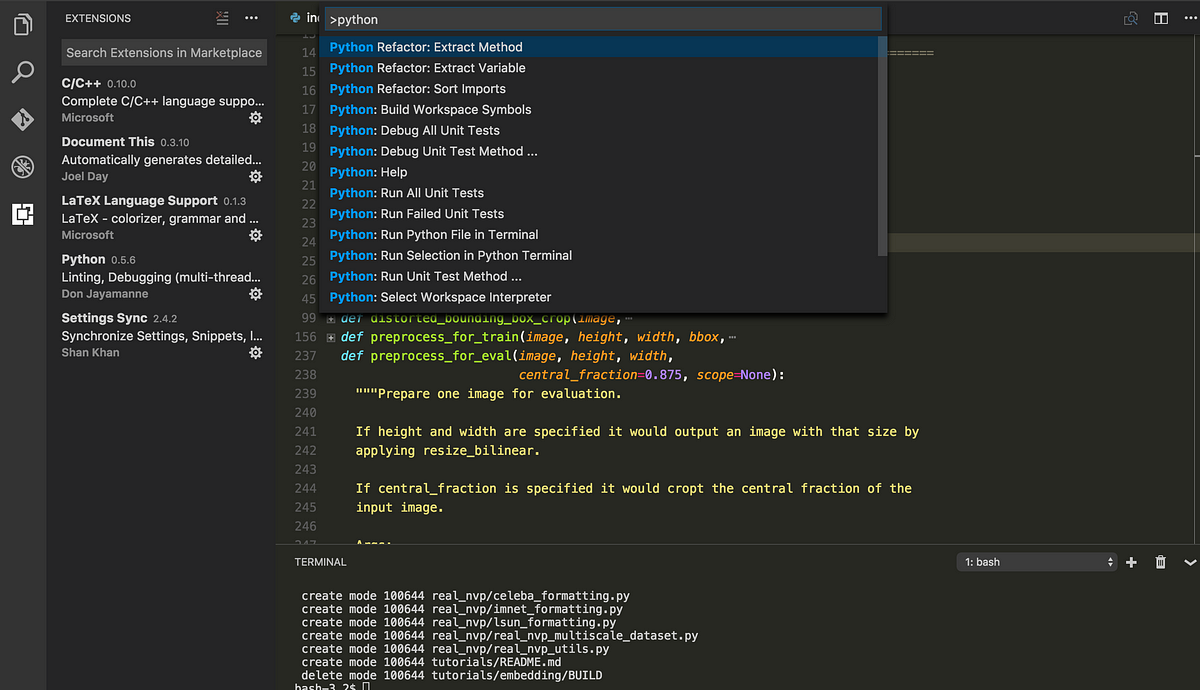Whether you’re a big, small or medium enterprise, Anaconda will support your organization. As a free and open-source distribution of Python and R programming language, it’s aim is to easily scale a single user on one laptop to thousands of machines. If you’re looking for a hassle-free data science platform, this is the one for you.
- I'm new to Mac, and I recently installed Anaconda on my laptop. When I installed Anaconda on my Windows laptop, my previous version on Python remained the default version. However, when I install Anaconda on my Mac. It seems to have erased my previous version. Or at least when I click on the old version it says 'Classic Environment no longer.
- MacOS graphical install¶. Download the graphical macOS installer for your version of Python. RECOMMENDED: Verify data integrity with SHA-256.For more information on hashes, see What about cryptographic hash verification? Double-click the downloaded file and click continue to.
How to run gurobipy in python 3.6 (in MAC) without Anaconda. Gabriel Lyon July 04, 2019 13:44; I have the Gurobi license up to date and i can run the module gurobipy in PyCharm but only using python 2.7. I would like to do this in python 3.5 or higher. Anaconda for Mac. Once the download has completed, double click on the downloaded.pkg file and follow the installation instructions. Once the install is complete, and once you close your current terminal and open a new one, typing python in your terminal window should invoke the Anaconda.
Extensive packages
Anaconda is leading the way for innovative data science platforms for enterprises of all sizes.
Anaconda provides you with more than 1,500 packages in its distribution. In it you will find the Anaconda navigator (a graphical alternative to command line interface), Conda package, virtual environment manager, and GUI. What makes Conda different from other PIP package managers is how package dependencies are managed. PIP installs Python package dependencies, even if they’re in conflict with other packages you’ve already installed. So, for example, a program can suddenly stop working when you’re installing a different package with a different version of the NumPy library. Everything will appear to work but, you data will produce different results because you didn’t install PIP in the same order. This is where Conda comes in. It analyzes your current environment and installations. This includes version limitations, dependencies, and incompatibility. As an open source package, it can be individually installed from the Anaconda repository, Anaconda Cloud or even the conda install command.
You can even create and share custom packages using the conda build command. The developers will then compile and build all the packages in the Anaconda repository, providing binaries for Windows, Linux and MacOS. Basically, you won’t worry about installing anything because Conda knows everything that’s been installed in your computer.
Extend your reach with Anaconda Navigator
The built in graphical user interface or GUI allows you to launch applications while managing Conda packages, environments and channels. This means the GUI will complete the process of installing packages without asking for a command-line command. It even includes these applications by default: JupyterLab & Jupyter Notebook / QtConsole / Spyder / Glueviz / Orange / RStudio / Visual Studio Code.
Where can you run this program?
Anaconda 2019.07 has these system requirements:
- Operating system: Windows 7 or newer, 64-bit macOS 10.10+, or Linux, including Ubuntu, RedHat, CentOS 6+.
- System architecture: Windows- 64-bit x86, 32-bit x86; MacOS- 64-bit x86; Linux- 64-bit x86, 64-bit Power8/Power9.
- 5 GB disk space or more.
Anaconda developers recommends you to install Anaconda for the local user so you won’t need administrator permissions. Or, you can opt to install Anaconda system wide, which does require administrator permissions.
Is there a better alternative?
If you’re looking for simple Python-dedicated environment, then you need PyCharm. Targeted specifically for Python programmers, this integrated development environment is filled with programming tools that can impress both new and experienced developers. It provides all the tools in a centralized system so you can increase your efficiency and effectiveness. Features like code analysis, graphical debugger, and unit tester helps you integrate Python programs with version control systems. In fact, every single output you make will be capable of web development from different web frameworks like Django, web2py, and Flask. It offers automated tools like code refactorings, PEP8 checks, and testing assistance to create your code, but what stands out the most is Smart Assistance. It fixes any of your errors or complete portions of your code. With PyCharm, you can expect a neat and maintainable code.
Our take
Anaconda’s host of innovative options makes it the best data science platform for all enterprises. By offering superior collaboration tools, scalability, and security, you never have to worry about gathering big data again.
Anaconda For Mac Python 3.6
Should you download it?
If you have experience with other package management and deployment programs, then make the big switch by downloading Anaconda.
5.0.0
MacOS Catalina was released on October 7, 2019, and has been causing quite a stir for Anaconda users. Apple has decided that Anaconda’s default install location in the root folder is not allowed. It moves that folder into a folder on your desktop called “Relocated Items,” in the Security folder. If you’ve used the .pkg installer for Anaconda, this probably broke your Anaconda installation. Many users discuss the breakage at https://github.com/ContinuumIO/anaconda-issues/issues/10998.
There is unfortunately no simple fix for your current installation. Some people have recommended moving the Anaconda folder from the “Relocated Items” folder back to your home folder, followed by modifying PATH to point at the new location. This is a partial fix, and may restore some core functionality for you. Unfortunately, many files in a given conda environment contain hard-coded paths to their install path (AKA prefix). When you copy or move folders around, these hard-coded paths are not accurate, and programs in your environment might look for other things in the wrong place and break.
So, where to go from here? You have several options.

Reinstallation
Choose one:
We have tested the currently available shell installers, and found them to work fine with Catalina. If you rely on the GUI installer instead, you’ll need to wait for the soon-to-be-released Anaconda 2019.10 installer, which will be signed and notarized in accordance with Apple’s more stringent policies.
Repair
This is experimental, but will allow you to fix your old installation and keep all of your old environments. To do this, you’ll use our self-contained prefix replacement tool at https://repo.anaconda.com/pkgs/misc/cpr-exec/cpr-0.1.1-osx-64.exe Note that although these files have a “.exe” file suffix, they are not Windows executables. We use the .exe suffix to indicate a standalone executable.
The experimental tool uses pyinstaller to make a standalone execution from code at https://github.com/conda/conda-prefix-replacement, which is a consolidated collection of the prefix detection and replacement code that is spread between conda and conda-build. We’ve added a novel feature to CPR for “rehoming” environments, which is the functionality needed to address the moved environment problem. Specifically, given the current (new) prefix, rehoming attempts to detect the old prefix from files within, and then adjust the detected files to have the new prefix value.
In steps:
1. At a terminal, download the file and make it executable:
2. Run the CPR tool to fix embedded paths:
Let’s say you started with an install to /Anaconda3, which Apple helpfully moved to “Relocated Items.” You have moved that folder to ~/anaconda3. Example commands for using CPR to fix this are:
Again, that finds your old prefix by looking in some files that are known to record the prefix in a readily parseable way. If that fails, you can still fix things as long as you know what the original path was:
The CPR command is recursive. Because environments default to the envs folder within your Anaconda[2|3] folder, CPR will fix all of your environments within your base prefix as well.
3. Re-run conda init to fix your conda shell command:
NOTE: if you use a shell other than bash, specify it in the conda init command:
4. Fix your ~/.conda/environments.txt file:

Anaconda For Machine Learning
Open the ~/.conda/environments.txt file, and find/replace all instances of the old install location (e.g. /Anaconda3) with the new one (e.g. ~/anaconda3).
5. Find any remaining references to the old environment in other configuration files:
Many packages in Anaconda manage their own configuration files, typically in some subfolder of your home directory. You can use a tool like grep or ripgrep to find these files. You’ll then need to edit them and fix the paths as you did with the environments.txt file. An example grep command might be:
We hope this helps you get back on track.
Enterprise Data Science
Anaconda Commercial Edition FAQRead MoreNews
Sustaining the open-source DS/ML ecosystem with the Anaconda Dividend ProgramRead MoreAnaconda For Machine Learning
For Practitioners
Behind the Code of Metagraph: Q&A with Core Architect Jim KitchenAdd Anaconda To Path Mac
